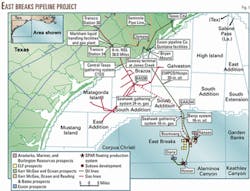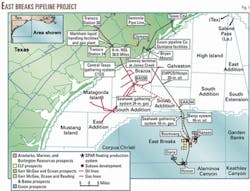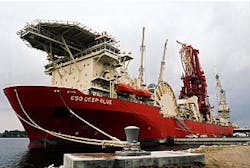Increased activity in deepwater Gulf of Mexico has created new opportunities for large-diameter infrastructure on the Outer Continental Shelf.
Williams Cos. Inc., Tulsa, and Stolt Offshore Inc., Houston, a relatively new pipeline installer in the Gulf of Mexico, and have just added new infrastructure while introducing new technology to speed the effort.
East Breaks is Williams' $200-million project and also involves Coflexip Stena Offshore (CSO) to install the deepwater oil and gas pipelines. The project includes installation of a new shelf platform and development of onshore facilities.
In late September, Stolt completed on schedule installation of the shelf portion of the East Breaks pipelay project off Texas, as reported (OGJ, Oct. 22, 2001, p. [?]). The shelf pipeline will gather gas production from the deepwater Boomvang-Nansen spars planned for the East Breaks area in 3,700 ft of water and destined for processing.
The Seahawk gas gathering system incorporates the deepwater and shelf installations and will have a production capacity of 360 MMcfd. With Williams' new oil export system, it will gather and transport oil and gas production from the two deepwater spar developments for producers Kerr-McGee Corp., Enterprise Oil PLC, and Ocean Energy Inc.
Target start-up of the entire production system is yearend 2001.
Seahawk, Banjo systems
Williams' total offshore project scheme includes the new 99-mile Seahawk system, a new shallow-water platform at Galveston Block A244, and a 41-mile Banjo deepwater line with a capacity of 80,000 b/d. Onshore, Williams is building a new 300-MMcfd gas processing plant near Markham, Tex. (Fig. 1).
For the shelf portion of the gas gathering system, Stolt installed 58 miles of 24-in. OD pipe from an existing platform at Brazos Block 538 in 97 ft of water to the Galveston Block A244 platform in 365 ft of water.
CSO has been completing the 41 mile, 18-in. OD deepwater portion of the gas system and the 41 mile, 16-in. OD oil export line this fall. The deepwater pipelines run parallel to each other from the Nansen-Boomvang production developments to Galveston Area Block A244.
Technical achievements
Both the shallow water and deepwater pipeline contractors achieved technical milestones on the East Breaks Project.
CSO used its newly fabricated CSO Deep Blue vessel designed to lay pipe at depths of up to 10,000 ft. Undertaking its first project worldwide, Deep Blue carried as much as 13 miles of 18-in. OD rigid steel pipe and up to 26 miles of 12-in. OD rigid steel pipe at a time, making runs out of Mobile Bay, Ala..
The 18-in. pipe has set a worldwide industry record as the largest rigid steel pipe to be reeled. CSO welded the line onshore in 1-mile increments then spooled the pipe onto a 102-ft diameter wheel aboard CSO Deep Blue before placing it on the ocean floor at reel-laying rates of up to a 1 mph (Fig. 2).
The 18-in., 16-in., and 12-in. diameter steel catenary risers (SCRs) also are being reeled directly to the spar platforms, marking another of the many worldwide firsts on this project.
The Stolt effort achieved a high lay-rate using Derrick Lay Barge 801, which recently mobilized to the gulf from West Africa. On June 28, DLB 801 achieved its highest lay rate of 327 joints in a single day on the 24-in., 0.562-in. WT pipe.
DLB 801 began pipelay in late May, and after tropical storm Allison moved out of the gulf, quickly ramped up to more than 250 joints/day with Stolt's Saturnax automatic welding system, a technology new for the Gulf of Mexico.
For much of the vessel's work from mid-June through July, the DLB 801 used an eight-point mooring spread to maintain a steady lay rate of 260 to 300 joints/day with only three welding stalls on the project.
Stolt owns the Saturnax system via its subsidiary Serimer DASA, which Stolt acquired in its merger with Stolt Comex Seaway and ETPM in December 1999. The Saturnax is a dual-torch gas metal arc welding and bug-and-band guiding system. It has completed more than a half-million welds since 1988 with low repair rates.
The dual-torch process is equivalent to four welders working at one time and doubles the rate of metal deposition. This process allows Stolt to achieve its highest production rates with half the number of welding stations.
Moreover, the dual-torch process, through the annealing effect of the second torch, increases the toughness of the weld while diminishing the hardness.
Natural gas in the line is metered and gathered from each spar at a central subsea junction in approximately 3,100 ft water. An offshore first, the project uses an ultrasonic gas measurement system aboard each of the spars. While ultrasonic gas custody transfer has been used on land, this is the first time the US Minerals Management Service has approved its use on an ocean platform.
At the subsea junction, the gas is commingled into the Seahawk gas export pipeline for transport to the Galveston Block A244 shallow-water platform, where Stolt tied in the shelf pipeline. The gas is then transported to the Brazos Block 538 platform, where the gas is tied into Williams' existing Central Texas gathering system.
It is then taken to the newly installed cryogenic Markham plant for processing. Built by Howe-Baker Engineers Inc., the plant commenced start-up activities Sept. 16.
The 300 MMscfd turbo-expander NGL-recovery plant is designed for high-pressure ethane recoveries (to 90%) using Ortloff Engineers Ltd.'s Gas Subcooled Process as well as essentially complete ethane rejection with high propane recovery (to 98.3%).
The project consists of inlet-gas filtration, 500-gpm inlet gas amine treating, triethylene glycol dehydration, molecular-sieve dehydration, cryogenic liquid recovery, product treating, 15,000 hp of pipeline delivery residue-gas compression, heat medium system, and associated utilities.
J Ray McDermott completed installation of the Galveston Block A244 platform in September. CSO Aker Gulf Marine fabricated the jacket and Omega Natchiq Inc. built the deck.
The multilevel deck includes two EMPCo Solar Taurus gas turbine-driven oil pumps to move the deepwater oil through the EMPCo HOOPS pipeline to shore for refining and marketing.
Stolt's shallow-work work included riser tie-ins at the existing Brazos Block 538 platform and tie-in of the pipeline at the Galveston Block A244. Stolt's Seaway Defender dynamically positioned vessel performed the tie-ins and pipeline testing, with saturation diving employed at the Galveston A244 location.
Stolt also trenched the shallow-end of the new pipeline up to the 200-ft contour line, using Horizon Offshore's Canyon Horizon jet barge to trench 37 miles of the pipeline to three feet below natural bottom.
The authors
Jim Mann is manager of the East Breaks pipeline project for Williams Cos. Inc.'s energy services business in Tulsa. He has 35 years' experience in process, mechanical and civil engineering, operations and maintenance, construction and project management for all types of oil and gas equipment and systems, processing plants, pipelines, and related facilities. Mann holds a BSc in mechanical engineering from Kansas State University and is a registered professional engineer in Oklahoma.
William T. Dick is a project manager with Stolt Offshore, which he joined earlier this year. Previously, he was a senior operations engineer for shelf projects with J. Ray McDermott for which he worked 11 years. Dick holds a bachelors degree in mechanical engineering from Purdue University at West Lafayette, Ind. He is an associated member of the American Society of Mechanical Engineers.




